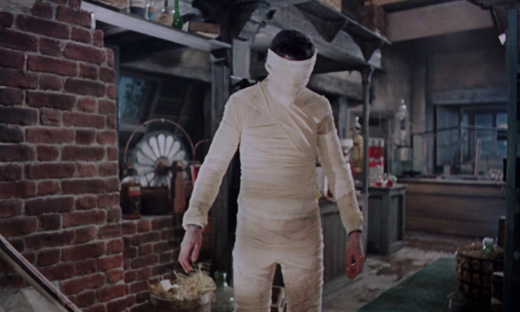
Written by Jimmy Sangster
Directed by Terence Fisher
UK, 1957
Having enjoyed success with the sci-fi horror film The Quatermass Xperiment (1955), the Hammer studio was keen to further exploit the apparent appeal of darker content – Quatermass had notably been one of the early recipients of the ‘X’ certificate – amongst the British public of the time. In the early stretches of the decade, horror cinema had mostly gone out of fashion, with the popular big-screen monsters now being of scientific or outer space origin. After Quatermass’ success, Hammer decided to resurrect the Frankenstein property, it being the blueprint fiction work for science leading to terror. The tragic creature of Mary Shelley’s creation had become a figure of mockery by the time of its 1948 encounter with Abbott and Costello, but Universal still held copyright despite the property’s apparent lack of profitability. As such, the script of Hammer’s reboot had to have as little to do with both Universal’s films and Shelley’s original novel as possible.
Despite having to avoid most of the novel’s story beats, The Curse of Frankenstein is far closer to the gothic tone of Shelley’s source, replacing James Whale’s almost fairytale-like aesthetic with a mid-Victorian Switzerland of elaborate sets, and playing up the gruesome meticulousness of Victor Frankenstein’s experimentation. The film also differed from the previous Hammer horror, swapping monochrome for striking Eastmancolor. Part of the critical revulsion towards the work at the time was based around the delivery of horror in the new colour medium, with Terence Fisher’s film reveling in blood reds and lurid greens that breathe life into the grisliness.
Other causes for complaint came from its frank depiction of the squeamish elements, with severed hands on full display in glowing colour, and departure from respectable norms in film narratives. Peter Cushing’s Victor, for example, cheats on his fiancée throughout the film, a misdeed that would normally be revealed to the wronged party and see Victor have to atone. Here, however, Hazel Court’s Elizabeth never finds out, with Victor’s disposing of evidence being one of the crimes for which he experiences no repercussions.
Jimmy Sangster’s screenplay deviates from Shelley in its depiction of both Frankenstein and his monster. The author’s rendering was heavy on sympathy for both parties: the creature was a being of initial innocence and sensitivity, while Frankenstein was misguidedly obsessive rather than close to actual evil. Here, Victor is cold, prone to blackmailing assistance from his friend and perfectly willing to sacrifice people for his own gains. The monster, meanwhile, has one scene where he cowers meekly while chained up in Victor’s laboratory, but at no point is his cause presented as sympathetic. He is a harbinger of uncontrollable instincts, prone to mindless violence upon encountering human life; the film notably subverts the friendly blind man interaction of the novel, with Christopher Lee’s creature killing the fearful senior almost immediately upon meeting him.
The film has held up remarkably well, far more so than Fisher’s own Dracula/Horror of Dracula from the following year, an equally trend-setting but ultimately middling work. The first half is admittedly bogged down a bit by too much expository chat, and the female characters are very under-realised, but the feature as a whole is a thrilling, macabre mood piece. While Fisher’s first Dracula is full of unintentional humour, primarily due to Michael Gough’s performance, credit must be given to The Curse of Frankenstein’s deliciously dark wit through juxtaposition and characters acting as though nothing untoward has happened. In one instance, an individual falls prey to the creature thanks to Victor’s actions, and after the demise the film cuts to him and Elizabeth eating breakfast. The very first line following that victim’s screams? “Pass the marmalade.”
Josh Slater-Williams



